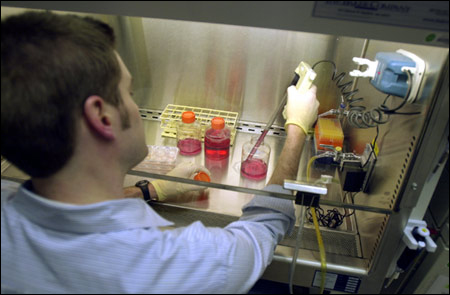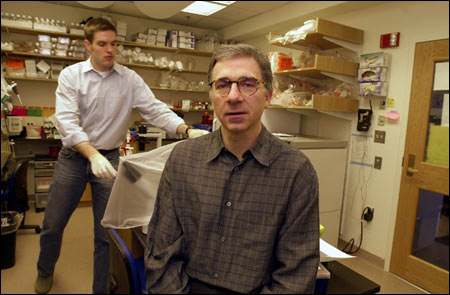Melton derives new stem cell lines
New stem cell lines promise new medical treatments

Driven by both personal and humane concerns, Doug Melton has produced 17 new lines of embryonic stem cells, which can, in theory, be coaxed into becoming any type of adult tissue from kidneys to spinal cords.
He isolated the cells from excess fertilized eggs obtained from in vitro fertilization clinics with their owners’ permission. The eggs are grown into embryos from which the stem cells are extracted before the embryos show any signs of life. The work was done with private funds because the U.S. government

limits federal funding for such research to 64 lines of frozen cells already in existence. These restrictions come from the belief by some people that embryos are alive and that cell extraction destroys them. Most scientists do not agree with this belief.
When Melton, Thomas Dudley Cabot Professor of Natural Sciences at Harvard and Howard Hughes Medical Institute investigator, looked into the supply of frozen stem cells, he judged it wholly inadequate. Information is lacking on the viability of many of these cell lines and access to others involves restricted usage. “I could not convince myself that any of the cell lines would be available or useful,” he says.
Also, some of the providers charge as much as $5,000 for the frozen cells. Melton thinks that something so important for the potential treatment of human ills ranging from Alzheimer’s and diabetes to Parkinson’s and spine repair should be free to all legitimate researchers. He plans to make the new lines developed at Harvard available to such researchers.
“I am gratified that Harvard can participate in the advancement of stem cell research, which holds such enormous promise for transforming the treatment of disease,” said William C. Kirby, Dean of the FAS and Edith and Benjamin Geisinger Professor of History. “Professor Melton’s creation of new stem cell lines, and the University’s wider collaborative efforts, can contribute significantly to worldwide research in this area.”
Melton has a very personal reason for wanting to experiment with high quality stem cells. His two children, Emma, 16, and Sam, 12, have insulin-dependent, or juvenile, diabetes. They frequently inject themselves with the insulin they need to stay alive, but that does not halt the gradual organ degeneration that can eventually lead to kidney failure, blindness, and malfunctioning limbs. Melton would like to be able to use stem cells to make working insulin-secreting cells that prevent this long-term suffering for them and a million others in the United States.
Finally, careful nurturing of embryonic stem cells in the laboratory should answer many questions about the earliest stages of human development, about how we become what we are. In Melton’s words, the stem cells “offer a unique window into the study of human early development.”

Potential vs. actual life
For all these reasons, Melton took things into his own hands. He contacted a local in vitro fertilization laboratory where couples who cannot conceive naturally do so with the help of eggs and sperm that are fertilized outside their bodies, then implanted into the mother’s womb. In the course of this process, embryos that are not implanted are frozen and stored. Melton worked with Boston IVF of Waltham, to obtain such fertilized cells. With the help of his colleagues at Harvard, including Chad Cowan and Andrew McMahon, and Doug Powers at Boston IVF, Melton developed the 17 new stem cell lines. The feat was announced at a scientific conference late last year and is described online in a March 3 report from the New England Journal of Medicine. The work was supported by Harvard University, the Juvenile Diabetes Research Foundation, and the Howard Hughes Medical Institute.
Melton got around federal funding restrictions, but what does he say to people who believe that life begins upon conception? “Unquestionably,” he answers, “the material from which these stem cells are derived has the potential to form a life. But this potential is very low. Those who say that frozen embryos are identical to children are mistaken. You cannot take a child and put it in a freezer. We need to draw a strong line between what has the potential for life and what is alive.

“Even more important,” he continues, “the material we used was slated for destruction. From that point of view, one could almost consider our position pro-life. We took something that was going to be destroyed and isolated cells from it that could improve the lives of people suffering from disease and trauma. I don’t know of any scientist who thinks this was a bad idea or that it should not have been done.”
Privately funded efforts to study the feasibility of using embryonic stem cells to treat disease and make replacements for malfunctioning organs are proceeding at Harvard and other universities, such as Stanford, Johns Hopkins, Wisconsin-Madison, Minnesota, and U.C., San Francisco. Harvard’s effort is expected to be the largest.
Last month, researchers in South Korea announced the creation of 30 embryos by a more controversial method – cloning. In this technique, human embryos were cloned from a single adult cell, then stem cells were removed from the embryos. Conceivably, the embryos can be grown into a full-term child, but the Korean scientists say they will not try to do this.
To expand the research done by Melton, Harvard University plans to establish a Stem Cell Institute devoted to research on the use of stem cells. That effort will include researchers from Harvard Medical School and several Harvard-affiliated teaching hospitals. The institute will be co-directed by Melton and David Scadden of Massachusetts General Hospital.




